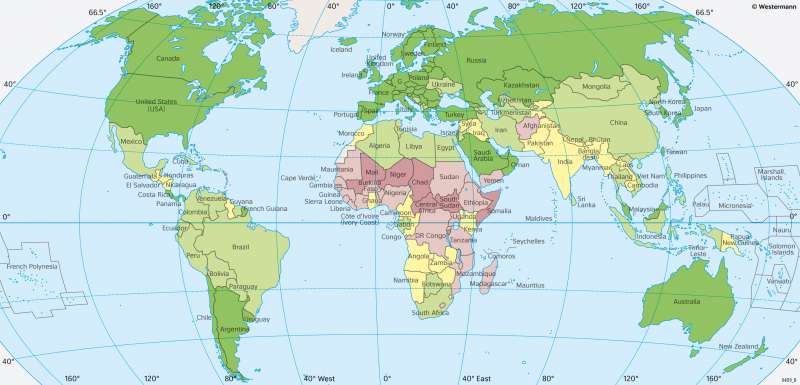The World - Level of development according to the Human Development Index (HDI)
Level of development
978-3-14-100890-6 | Page 34 | Ill. 1

Overview
In the course of increasing international cooperation and interdependencies, not only in strategic and economic terms, the big question arose: How could the level of development of a country be recorded statistically and put in relation to other states on earth? In order to establish the best possible international comparability, a special index was developed about three decades ago - the Human Development Index.
The Human Development Index (HDI) measures the standard of living in different countries by means of a number of factors and has been published annually since 1990 in the Human Development Report (HDR) of the United Nations. This map on the level of development of countries is based on the HDI.
Living condistions worldwide
Living conditions vary greatly around the world. Around 60 countries have an HDI greater than 0.8 and thus a very high level of development. In almost half as many countries, however, living conditions are poor to very poor (HDI < 0.550).
The map shows a pronounced development gap between the OECD countries and many countries in Africa and Asia. Apart from the OECD countries, only a few countries have a very high level of development, including Israel, Oman, Malaysia, the United Arab Emirates and Argentina as well as Chile. In Africa, only very few countries have a "high" level of development and a few more have a "medium" level of development. In most states the HDI it is very low.
Asia also shows a heterogeneous picture with sometimes sharp contrasts in sub-regions (for example Afghanistan, Iran, United Arab Emirates). At the same time, Asia is the continent with the greatest dynamic for change, which can be seen, for example, in the development of South Korea or Malaysia in recent decades. Latin America is better developed than Africa and Asia, but there are strong contrasts between emerging countries like Costa Rica and others like Haiti, Guatemala and Nicaragua, some of which have been shaken by long civil wars. Countries with a high or very high level of development border on countries with only a medium level of development. Within Europe there is a west-east divide, while the former north-south divide has almost disappeared.
The calculation of the Human Development Index (HDI)
The Human Development Index is made up of three components:
1. mean life expectancy at birth (see maps 35.3 and 35.5): this is used to represent health care and access to medical care, but also allows conclusions to be drawn about food and drinking water supplies, hygiene conditions and factors such as old-age security. An important factor in the calculation of mean life expectancy is infant mortality.
2. the level of education, measured by the average and expected duration of school attendance in years (cf. map 35.4), represents knowledge and participation in public and political life. Furthermore, it allows conclusions to be drawn about the equality of men and women and the safeguarding of children's rights.
3. the material standard of living, measured by the gross national income (GNI) per capita taking into account the respective cost of living (purchasing power adjustment), reflects the level of economic level of economic development and incomes. This single indicator is controversial because the average value says little about the often unequal distribution within the population.




